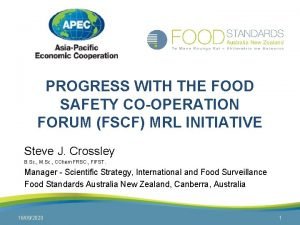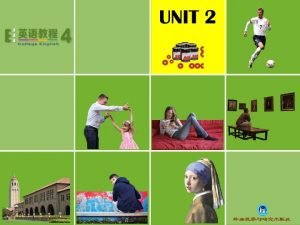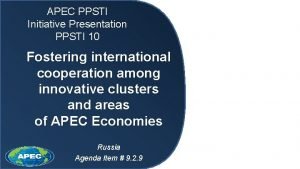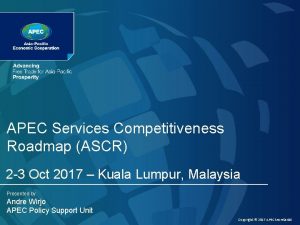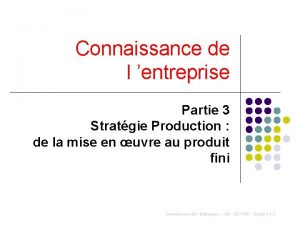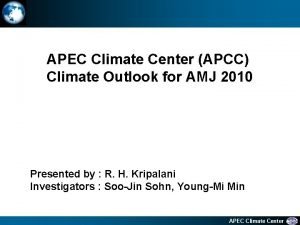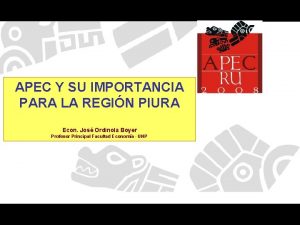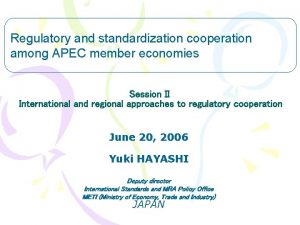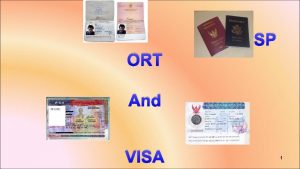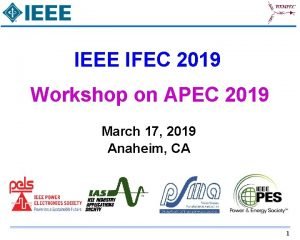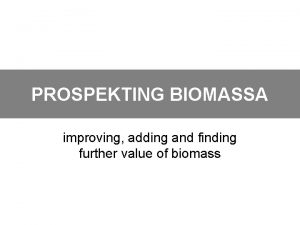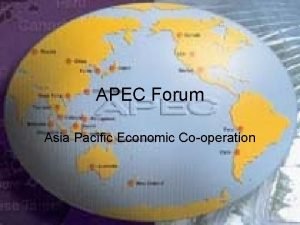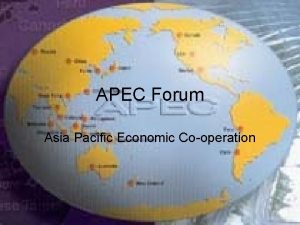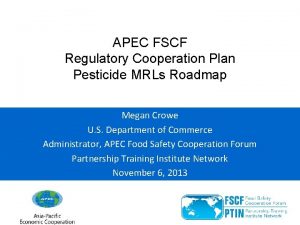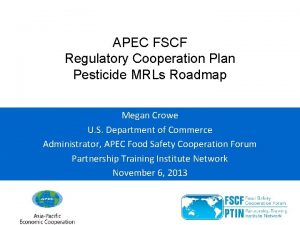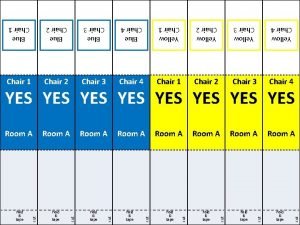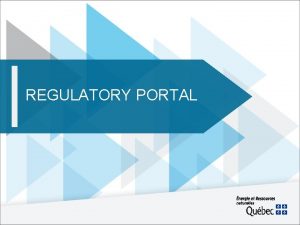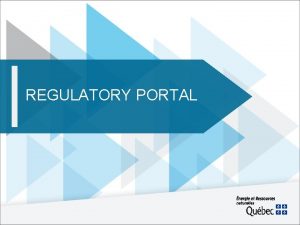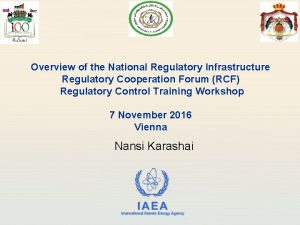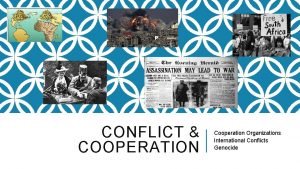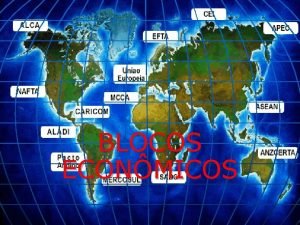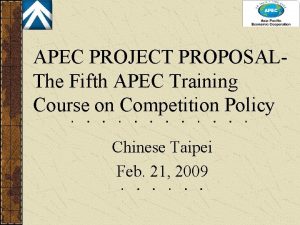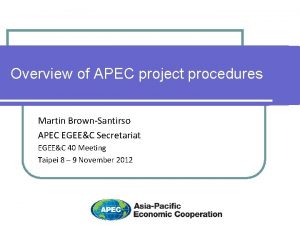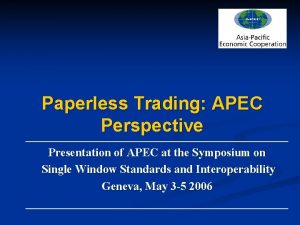Regulatory Cooperation in APEC Julia Doherty Chair APEC





















- Slides: 21

Regulatory Cooperation in APEC Julia Doherty Chair, APEC Subcommittee on Standards and Conformance

• Background on APEC • 2011 Initiatives on Regulatory Cooperation and Regulatory Convergence • Examples of sectoral work: toys, food, smart grid, solar technologies, wine, green buildings • Conclusions

• To develop and strengthen the multilateral trading system; • To increase the interdependence and prosperity of member economies; and • To promote sustainable economic growth.

APEC Member Economies Page 4 of (21) Inside APEC Copyright © 2010 APEC Secretariat

Economic Profile of APEC World 6. 7 billion World US$40 trillion World US$61 trillion APEC 2. 7 billion APEC US$17 trillion APEC US$32 trillion Source: Department of Trade and Foreign Affairs, Australia (2009), "The APEC Region Trade and Investment 2009”

APEC 2011 Priorities Strengthening regional economic integration and expanding trade Promoting green growth Expanding regulatory cooperation and advancing regulatory convergence

Promoting Regulatory Convergence • Strengthen implementation of good regulatory practices the “APEC-OECD Integrated Checklist on Regulatory Reform” § Internal, inter-ministerial coordination of rulemaking to enable a “whole of government approach” § Assess the impact of alternatives to achieve a regulatory objective § Increase transparency and strengthen mechanisms of public consultation

Advancing Regulatory Cooperation in APEC Guiding principles for APEC activities on regulatory matters • Advance the multilateral trading system • Focus on achieving practical outcomes that matter • Advance implementation of the APEC-OECD Checklist • Promote alignment to international standards and conformance infrastructure • Engage key stakeholders, ensure outcomes are transparent

Sub-Committee on Standards and Conformance (SCSC) • Reduce negative effect on trade due to differing standards, technical regulations and conformity assessment procedures • Promote greater alignment of national standards with international standards and greater consistency of approaches to conformity assessment • Promote good regulatory practices and transparency of standards, technical regulations and conformity assessment procedures • Encourage cooperation on the development of technical infrastructure • Promote greater regulatory dialogue • Encourage business involvement in standards and conformance activities

Toy Safety Initiative • Goal: To increase transparency, encourage better alignment and reduce unnecessary impediments to trade related to toy safety standards and practices while promoting a high level of product safety • Relevance: High profile toy safety incidents in 2007/2008, 11 of 21 economies had notified WTO of regulatory changes related to toy safety, 19 of 21 economies exported toys • Method: Trade, regulatory and national standards body officials from 20 economies and ICTI, CEN TC 52, ASTM F 15, COPOLCO, ILAC experts, industry and other experts came together in Singapore and Hong Kong, China.

Key Outcomes of the APEC Toy Safety Initiative • Greater transparency in regulatory systems ▫ The APEC Toy Safety Survey completed by all 21 APEC economies • Concrete moves towards better alignment ▫ A pledge by ASTM International and ISO to support greater technical cooperation and an agreement to hold future joint meetings ▫ Establishment of ISO Advisory Panel to determine toy standard alignment priorities ▫ WG on emerging hazards: Cadmium in children’s jewelry • Sustained international regulatory cooperation ▫ APEC Product Safety Contact List with the OECD Consumer Product Safety Working Group ▫ Participation by eight (8) APEC Toy Safety Regulators in ICPHSO in Orlando, Florida in 2010 ▫ Meeting of APEC regulators in ICPHSO in Korea in 2011; potential future cooperation with OECD on project

Wine Regulators’ Forum • Goal: To increase transparency, encourage better standards alignment and reduce unnecessary costs associated with unnecessary certification requirements • Relevance: Wine imports in APEC up 120+ percent over last decade; wine production in APEC increasing in parallel with trade; in China alone wine production increased 37% in 2009. • Method: Produce compendium of wine import certificate requirements across APEC economies. Bring trade, regulatory, industry and other experts together in San Francisco. • Outcomes: Use established networks to build out cooperation to establish mutual priorities and build confidence, to reduce barriers to trade (including those relating to certification requirements) and to increase info exchange.

Food Safety Cooperation Forum • Goal: To enlist leadership from the private sector and academia to bring additional expertise, resources and commitment to fulfilling critical food safety capacity building needs identified by APEC food safety regulators. • Relevance: Food safety capacity building facilitates trade and improves public health. Use of science –based regulations and best practices that are consistent with international standards result in improved transparency, reduction of technical trade barriers, facilitation of imports and exports, and improved consumer confidence • Method: Bring together food safety regulators every two years to enhance regulatory cooperation and dialogue. Use Partnership Training Institute Network (PTIN) to bring in industry and academic expertise to address critical food safety capacity building needs through workshops and development of reproducible training modules

Key Outcomes of the Food Safety Cooperation Forum • Collaborate to Improve Lab Competency and Address Trade Concerns ▫ Improved technical skills mean more accurate testing while emphasis on science in food testing and sampling means fewer hold ups at the border • Reduce Unnecessary Export Certificate Requirements ▫ APEC work to foster improved implementation of Codex guidance resulted in bringing new clarity on attestations to CODEX CCFICS • Use public-private partnership model to enable sustainable capacity building ▫ Longstanding APEC collaboration with World Bank resulted in public and private donations to launch a new Global Food Safety Multi-Donor Trust Fund to takes APEC capacity building approach global

2011 Ministers Responsible for Trade Big Sky, Montana APEC should leverage the linkages between economic and environmental challenges facing the region in a way that creates new sources of economic growth, including the transition towards a global low carbon economy…. . Given the tremendous potential of emerging technologies in enhancing growth and strengthening environmental protection; it is important to ensure that standards, conformance systems, and new regulatory schemes do not create unnecessary barriers to trade in related products.

Solar Technologies Standards and Conformance Initiative • Goal: To increase transparency, encourage better standards alignment and provide a baseline on the use of standards, regulations, and conformity assessment schemes for Photovoltaics (PV), Solar Water Heating and (SWH), and Concentrated Solar Power (CSP) among APEC economies. • Relevance: Leadership role by APEC economies providing a platform to encourage experts involved in standards development and regulation of solar products in APEC to cooperate and exchange information on standards-related solar activities. • Method: 15 of 21 participated in the APEC Survey on current standards and regulations for PV, CSP, and SWH technologies. Experts were assembled for a policy discussion on standards and conformity assessment in San Francisco and on the specific issue of reliability and durability of solar panels in Taipei. • Outcomes: Interest for continued collaboration on standards in various standards bodies, and long term working relationships with regulators.

Key Outcomes - Solar Technologies Standards and Conformance Initiative • Commitment to greater participation and use of international standards -- recognizing that local conditions (eg, building construction, installation codes and grid design) may require limited national differences. • Cooperation on the development of a strong technical basis for all test procedures including those used as the basis for product certification, labeling and product safety standards. • Greater recognition of certification bodies’ audits of production facilities to decrease the needs for multiple audits of one facility. • Recognition that training and education programs for customers can improve the effective use of international standards for quality assurance and quality management. Training and certification of solar technology professionals, specifically installers, is important to ensure codes and standards are properly applied throughout the APEC economies • The establishment of standardized monitoring methods and surveillance requirements for solar resource measurement and evaluation to assure project investors of accurate site resource prediction.

Green Buildings and Green Growth • Goal: Encourage use of international standards and systems of conformity assessment, build stakeholder participation in standards development, encourage alignment of national rating systems to minimize trade disruptions • Relevance: Commercial building sector a major energy user. Advancing this work can address shared goals of sustainable growth, improving energy security and reducing GHG emissions. • Method: Work on green building involves a complex interplay of stakeholders include government building authorities, building owners, standards developers, rating systems, and industry suppliers of building materials. Green buildings workshops in Washington and Singapore have forged a network where public and private stakeholders can exchange information , including on decisions on the use of voluntary or mandatory programs.

Key Outcomes Green Buildings and Green Growth • Greater transparency ▫ The APEC Survey on Sustainability in Buildings completed by 19/21 APEC economies ▫ Case studies on green building rating programs and trade impact of Life Cycle Assessment in plumbing and flooring certification programs ▫ Knowledge exchange with World Bank/IFC, World Green Building Council • Consensus that voluntary initiatives, market-driven programs and government-led efforts all have roles in promoting greater sustainability in the built environment • Standards and conformity assessment provide consensus solutions ▫ Encourage greater stakeholder engagement and maximizing use of international standards and referencing existing standards in meeting objectives • Enhanced policy coordination ▫ Joint APEC-ASEAN work considered a model for future cooperation ▫ Cooperation with UNEP and other organizations on understanding of green metrics and expanding availability of data on green performance

Improving Outcomes and Preventing Technical Barriers to Trade § Share technical data and assessments § Improve transparency and stakeholder input § Strengthen technical and regulatory analysis § Improve alignment and build confidence Ø Increase the reliability and diffusion of technology Ø Achieve more rapid realization of societal benefits

For more information • APEC-OECD Integrated Checklist for Regulatory Reform • “Strengthening Implementation of Good Regulatory Practices”, proposal submitted by United States, New Zealand, Australia, Mexico, 2011/SOM 3/025 • “APEC Regulatory Cooperation Plan, ” proposal submitted by the United States, 2011/SOM 3/026 • APEC Toy Safety Initiative (www. toyassociation. org) • APEC Food Safety Cooperation Forum and Partnership Training Institute (http: //fscf-ptin. apec. org) • APEC Regulatory Cooperation Advancement Mechanism (ARCAM) on Smart Grid Interoperability Standards (http: //www. nist. gov/smartgrid/international-coordination. cfm) • APEC Standards and Conformance Initiative on Solar Technologies • APEC Initiative on Commercial Green Buildings
 Apec food safety cooperation forum
Apec food safety cooperation forum Fraser doherty superjam
Fraser doherty superjam Conor doherty model
Conor doherty model Fred doherty
Fred doherty Aisling doherty
Aisling doherty Michael doherty maynooth
Michael doherty maynooth Fraser doherty jam
Fraser doherty jam Willie doherty photographer
Willie doherty photographer Teresa doherty darts
Teresa doherty darts Rómeó és júlia jellemzése
Rómeó és júlia jellemzése Apec
Apec Apec ppsti
Apec ppsti Apec services competitiveness roadmap
Apec services competitiveness roadmap Mapa del apec
Mapa del apec Apec
Apec Apcc climate
Apcc climate Apec 2006
Apec 2006 Apec
Apec Apec
Apec Apec project guidebook
Apec project guidebook Apec 2019
Apec 2019 Apec
Apec
